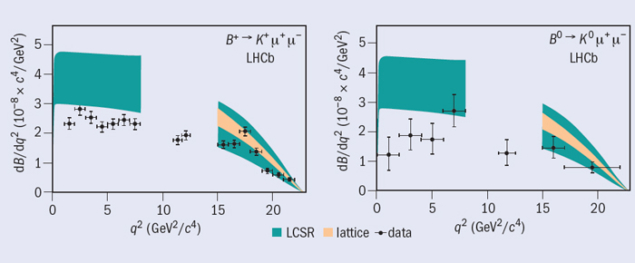By the time that the first long run of the LHC ended early in 2013, the LHCb experiment had collected data for proton–proton collisions corresponding to an integrated luminosity of 2 fb–1 at 8 TeV, to add to the 1 fb–1 of data collected at 7 TeV in 2011. The first batch of data allowed the LHCb collaboration to announce a variety of results, many of which have now been updated using the larger data sample and/or by including different decay channels. At the 2014 Rencontres de Moriond conference in March, the collaboration presented more precise results from a number of different analyses.

The flavour-changing neutral-current decay B → K*μ+μ– is an important channel in the search for new physics because it is highly suppressed in the Standard Model. While there are relatively large theoretical uncertainties in the predictions, these can be overcome by measuring asymmetries in which the uncertainties cancel. One of these is the isospin asymmetry, based on the differences in the results of measurements of B0 → K*μ+μ– and B+ → K*+μ+μ–. The Standard Model predicts this isospin asymmetry to be small, which LHCb confirmed in 2011, based on 1 fb–1 of data. On the other hand, a similar analysis for decays in which the excited K* is replaced by its ground state K, showed evidence for a possible isospin asymmetry.
Now, the analysis of the full 3 fb–1 of data, which was presented at the Moriond conference, gives results that are consistent with the small asymmetry predicted by the Standard Model in both the K* and K cases. However, even if this confirms that the difference between B0 and B+ decays is small for this channel, there is a tendency for the differential branching fractions to have lower values than the theoretical predictions, as the figures show.
Another interesting result that LHCb has now refined concerned the exotic state X(3872), which was discovered by the Belle experiment at KEK in 2003. The nature of the X(3872) is puzzling because although it appears charmonium-like, it does not fit in to the expected charmonium spectrum. Exotic interpretations include the possibility that it could be a DD* molecule or a tetraquark state.
With the data from 2011, LHCb unambiguously determined its quantum numbers JPC as 1++. At Moriond the collaboration went further by presenting a measurement of the ratio of the branching fractions for the decay of the X(3872) into ψ(2S)γ and J/ψγ. This ratio, Rψγ, is predicted to be different depending on the nature of the X(3872). LHCb finds Rψγ = 2.46±0.64±0.29, which is compatible with other experiments but more precise. This value does not support the interpretation as a pure DD* molecule.
Further reading
M Patel LHCb Collaboration 2014 LHCb-TALK-2014-034.
I Polyakov LHCb Collaboration 2014 LHCb-TALK-2014-047.








